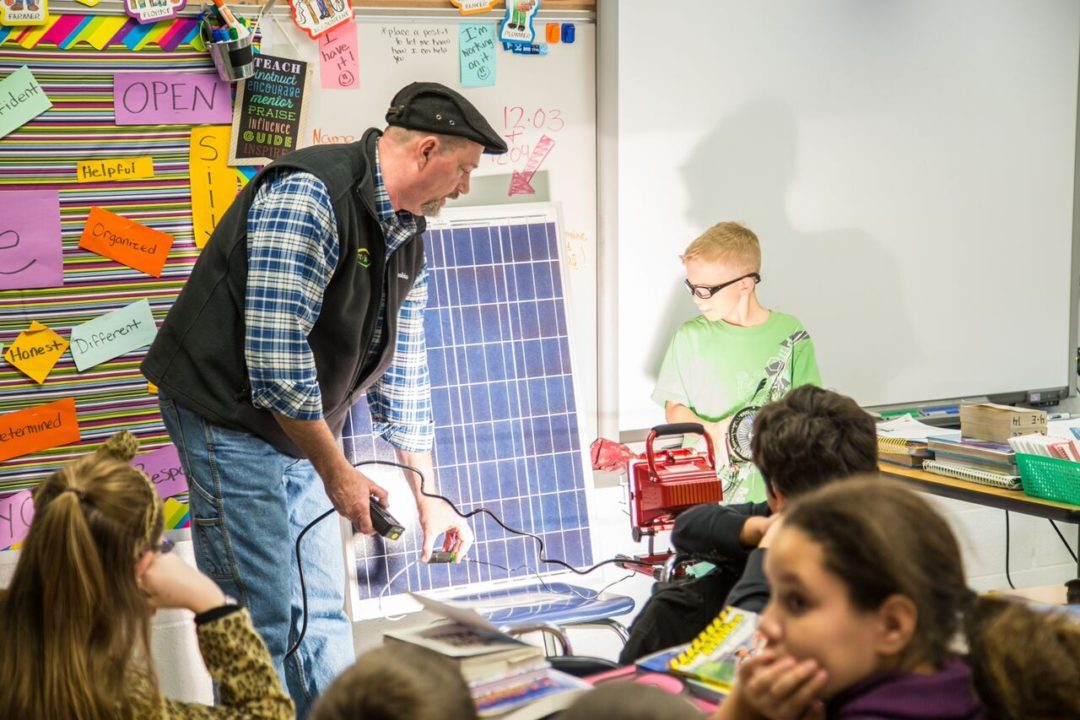By. Roxie Brown, Program Manager, The Solar Foundation
The Solar Foundation (TSF) is an independent nonprofit organization, based out of Washington DC, which was founded in 1977. The mission of TSF is to increase understanding of solar energy through strategic research and education that transform markets. TSF is also the founder and co-chair of the National Solar Schools Consortium.
What is the National Solar Schools Consortium?
The National Solar Schools Consortium is a group of solar businesses, advocacy groups, and nonprofit organizations from across the country that work together to support the national solar schools movement. The main goals of the Consortium are to coordinate, aggregate, and amplify the national efforts being made in the solar schools movement. By acting as a unifying voice for all of the state and regional advocacy groups, the Consortium fortifies the efforts of the group members, making the whole much more than the sum of its parts. The Consortium is hosted and led by TSF, co-chaired by the Brian D. Robertson Memorial Solar Schools Fund, and supported by a small executive committee. Its goal is to have 2,000 member organizations registered by 2020. (To become a member, email Schools@SolarFound.org for more information.)
TSF’s biggest contribution to the solar schools movement to date has been the release of the National Solar Schools report, entitled “Brighter Future: A Study on Solar in U.S. Schools.” This report was a comprehensive snapshot of every solar school in the nation, as of 2014. TSF also created an interactive map that houses every address, solar capacity, and name of every school in the nation. One of the map’s most interesting features is the solar potential it measures, showing over 70,000 schools in America that could “go solar” cost effectively today.
Other key findings of the “Brighter Futures” report:
- There are currently 3,752 K-12 schools with solar installations. This equates to nearly 2.7 million students attending solar schools.
- The 3,727 PV systems have a combined capacity of 490 megawatts (MW), equivalent to $77.8 million worth of utility bills and enough clean, renewable energy to offset 50 million gallons of gasoline.
- Of the 125,000 K-12 schools in the country, up to 72,000 schools (60%) can “go solar” cost-effectively.
- Approximately 450 individual school districts have the potential to save more than $1 million over 30 years by installing a solar PV system.

Photo Courtesy of Roxie Brown
Incorporating Solar in Schools
As a founder of the Consortium, TSF is committed to providing schools with information on adapting solar energy into their every day operations. Solar can be incorporated into schools and classrooms through several approaches, specifically, on-campus solar systems and curriculum. On-campus solar systems are very powerful because they allow students to learn about solar energy generation first-hand.
There are two types of solar installations a school can invest in. The first is an educational-only installation, or a system that is installed strictly for educational purposes and is not intended to save the school money or lower energy usage. The second is an energy off-setting installation, which is an installation that is sized strategically to off-set the school’s energy usage and energy bills. These systems save the schools money and have a positive impact on the environment.
Solar and renewable energy curriculum integration is another way for a school to incorporate solar without installing anything on campus. The National Energy Education Development (NEED) Project is a member of the Consortium’s executive committee and they are responsible for creating energy education curriculum for K-12 schools. They have an incredible database of lesson plans and curriculum on their website, as well as energy learning classroom kits that can be purchased for enhanced, hands-on learning. Schools may also choose to invite a solar energy professional to come and speak to the students. TSF has one staff member currently available to do school visits and solar/renewable energy presentations for K-12 classes.
How to Go Solar
Interested in learning if your school could cost-effectively install solar on campus? If so, then follow the steps below:
- Email Schools@SolarFound.org with initial questions or to be connected with a high-quality solar installer in your area.
- Receive a FREE solar assessment for your campus.
- You will need to provide your energy bills for the previous year.
- You will also need to give the installer access to your rooftops and/or desired ground mount location (if applicable).
- If your school has solar capacity AND if your electricity rates are high enough to result in a rapid ROI (return on investment), you will then be able to determine the size and cost of your system.
- If you are a public school and your system cost is over $25,000, you may have to put your installation to public bid (releasing a Request for Proposal (RFP) to ensure the lowest cost of installation).
- The next step will be to determine financing;
- Small “education-only” systems are often no more than 5kW in size, and no more than $5,000. Schools often fundraise for these systems. Click HERE for tips on fundraising campaigns.
- Larger “energy off-setting” installations are often funding by a Power Purchase Agreement (PPA). This is a form of third party ownership financing wherein an organization with a large tax appetite will invest in the solar installation, take advantage of the tax credits, and the school pays just for the energy produced. This approach requires no capital outlay by the school and hedges against rising energy costs for the lifetime of the system.
- If you would like to incorporate curriculum in addition to your system OR if you are interested in curriculum only, you can email Schools@SolarFound.org to request information about our curriculum provider partners.
- If you would like to have a solar energy professional come speak at your school, please email Schools@SolarFound.org and TSF will try to get you on our calendar for 2016.
How Schools Have Benefited from Going Solar
Almost every solar school TSF has engaged with has had great things to say about their students’ engagement and excitement over the systems and/or energy curriculum. One recent school that TSF visited in West Virginia had a great experience to report regarding their campus installation. The school had an 8kW awning system installed on the side of one of their buildings. TSF’s visit to the school included a presentation to the 5th graders, all of whom had incredibly insightful questions and comments about the potential of solar. By installing solar with a monitoring system, the students were able to watch the energy production numbers rise year after year, and they were able to really conceptualize the energy generation that was taking place on their campus.

8kW awning system installed on the side of a school in West Virginia
Photo Courtesy of Roxie Brown
Recently, the Pajaro Valley Unified School District in Watsonville, CA also went solar, including three high schools, two middle schools, and one elementary school. This instance is a prime example of an energy off-setting installation, as these systems were sized strategically to save the district money.
“The $9 million project was paid for by Measure L funds, the $150 million bond measure approved in 2012 that is funding hundreds of repair, maintenance, and construction projects throughout the district. It is expected to save Pajaro Valley Unified School District an estimated $1 million annually.” – Tarmo Hannula, Register Pajaronian Reporter.
In speaking with the Watsonville High School Principal, it was reported that the system has been “a great learning experience for all involved!”
If you represent a solar school and you would like your testimonials, system pictures, or videos shared on the Solar Schools Consortium’s website, please email Schools@SolarFound.org and we will be happy to highlight you on our blog!
Looking Ahead
The Solar Schools Consortium’s goals for the future include growing its membership base, expanding member benefits and program offerings, and empowering its members through coordination, aggregation, and amplification of national efforts being made to advance solar schools. The consortium welcomes new members on an ongoing basis. If you are interested in learning more about membership and getting involved, please reach out by emailing Schools@SolarFound.org
About Roxie Brown:
Roxie Brown is the Solar Schools program manager at The Solar Foundation. She is responsible for managing the National Solar Schools Consortium and also works on the DOE funded program entitled “Solar Powering America by Recognizing Communities” or “SPARC” program. Before coming to TSF, Roxie worked for America’s largest solar panel manufacturer, SolarWorld, where she managed their national solar installer program and directed their annual dealer conferences. Roxie brings with her a lifelong passion for renewable energy and energy education, stemming from an early childhood experience she had when a renewable energy guest speaker came to her elementary school. This guest speaker inspired her to “change the world” by making a career out of alternative energy advocacy, and her life has had an according trajectory ever since. In high school, she spearheaded a biodiesel school bus project, earning a national award for energy leadership. She then went on to earn a BA from UC Davis in International Energy Policy before being hired by SolarWorld in 2011. Finally landing at TSF in 2015, Roxie feels that her role as the National Solar Schools Program Manager is the culmination of her life’s passions – combining renewable energy and education. In her free time, Roxie enjoys writing, weight training, and guest speaking at schools about renewable energy.



